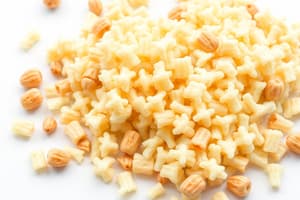Podcast
Questions and Answers
What are the four major tasks involved in digestion in mammals?
What are the four major tasks involved in digestion in mammals?
Ingestion, digestion, absorption, elimination
Which organ in humans aids in chemical digestion by producing gastric juices and the enzyme pepsin?
Which organ in humans aids in chemical digestion by producing gastric juices and the enzyme pepsin?
Stomach
Where does most nutrient absorption occur in the digestive system?
Where does most nutrient absorption occur in the digestive system?
Small intestine
What is the function of the large intestine, or colon, in digestion?
What is the function of the large intestine, or colon, in digestion?
Which organs release digestive juices, produce bile, and neutralize acid chyme during digestion?
Which organs release digestive juices, produce bile, and neutralize acid chyme during digestion?
What is the first step of digestion that occurs in the mouth?
What is the first step of digestion that occurs in the mouth?
Explain the role of transcription factors in determining cell specialization.
Explain the role of transcription factors in determining cell specialization.
What are stem cells and how do they differ from specialized cells?
What are stem cells and how do they differ from specialized cells?
Discuss the significance of stem cells in organ/tissue regeneration.
Discuss the significance of stem cells in organ/tissue regeneration.
Where do stem cells exist in the body, and what is their role?
Where do stem cells exist in the body, and what is their role?
How do internal and external cues influence stem cells during their differentiation process?
How do internal and external cues influence stem cells during their differentiation process?
Flashcards are hidden until you start studying
Study Notes
- The platypus is a unique mammal that can lay eggs and has venomous spurs on its legs, and interestingly, it is considered to not have a stomach according to its definition as an organ containing gastric glands.
- Digestion in mammals, including humans, involves four major tasks: ingestion, digestion, absorption, and elimination.
- In humans, digestion starts in the mouth where saliva containing enzymes breaks down biomolecules chemically, while teeth aid in mechanical digestion.
- Peristalsis helps move food from the mouth to the stomach via the esophagus, while the stomach performs chemical digestion with gastric juices and enzymes like pepsin.
- The small intestine is where significant chemical digestion of all four biomolecules occurs, aided by enzymes and digestive juices from organs like the gallbladder, liver, and pancreas.
- Most nutrient absorption happens in the small intestine through the lining with villi and microvilli, providing a large surface area for absorption.
- The large intestine, or colon, focuses on reabsorbing water and housing beneficial bacteria, with the final step being elimination through the rectum and anus.
- Organs like the liver, gallbladder, and pancreas play crucial roles in digestion by releasing digestive juices, producing bile, and neutralizing acid chyme, respectively.
Studying That Suits You
Use AI to generate personalized quizzes and flashcards to suit your learning preferences.




